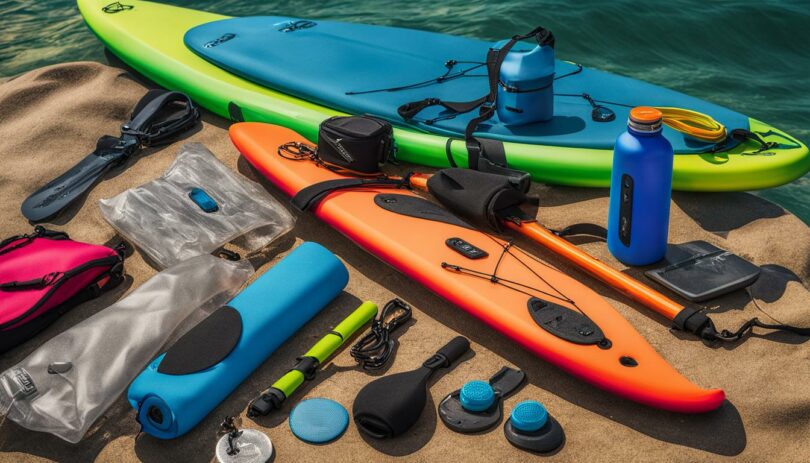Paddle sports encompass a variety of water activities that require the use of a paddle to navigate and propel a vessel. These include canoeing, kayaking, paddleboarding, and rafting. Paddle sports offer a thrilling and adventurous experience on the water, and they have gained popularity in recent years. Whether you’re a beginner or an experienced paddler, there are various techniques, accessories, and equipment available to enhance your paddle sports experience and improve your skills.
Key Takeaways:
- Paddle sports include canoeing, kayaking, paddleboarding, and rafting.
- These activities provide an adventurous experience on the water.
- There are various techniques, accessories, and equipment available to enhance your paddle sports experience.
- Paddle sports offer opportunities for both beginners and experienced paddlers to improve their skills.
- Engaging in paddle sports provides both physical and mental health benefits.
Canoeing: A Serene and Versatile Paddle Sport
Canoeing is a popular paddle sport that offers a serene and versatile experience on the water. Canoes are long and slender boats that can be paddled solo or in tandem. They are propelled using a single-bladed paddle and offer various paddling techniques for different purposes, including recreational canoeing and whitewater canoeing. Canoeing can be combined with other outdoor activities such as camping, fishing, and hunting, making it a favorite among the outdoor community. There are also a variety of accessories available to enhance the canoeing experience, such as paddles, life jackets, and storage solutions.
When it comes to recreational canoeing, the focus is on enjoying the tranquility of the water while leisurely paddling along calm lakes or gently flowing rivers. This type of canoeing is perfect for nature enthusiasts who want to explore scenic landscapes and observe wildlife. On the other hand, whitewater canoeing is an exhilarating adventure for thrill-seekers. It involves navigating fast-moving rapids, maneuvering through obstacles, and maintaining balance and control in dynamic water conditions. Whitewater canoeing requires advanced paddling skills, knowledge of river safety techniques, and specialized equipment to ensure a safe and exciting experience.
Regardless of the type of canoeing you choose, having the right canoe accessories is essential. A sturdy and lightweight paddle is crucial for efficient propulsion and maneuverability. Life jackets or personal flotation devices (PFDs) are essential for safety on the water. They provide buoyancy and protect against accidents or unexpected falls. Additionally, there are various storage solutions available, such as waterproof bags or containers, to keep your belongings dry and secure during your canoeing adventures. Choosing the appropriate canoeing accessories will enhance your comfort, safety, and overall enjoyment of this serene and versatile paddle sport.
Kayaking: Mastering Techniques and Enhancing Your Experience
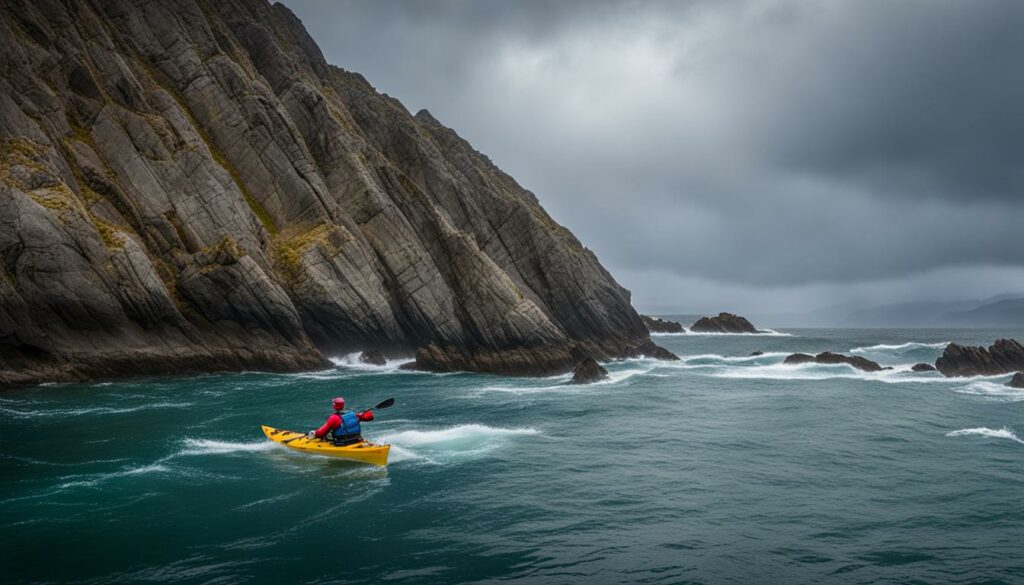
Kayaking is a dynamic paddle sport that offers thrilling adventures on the water. Whether you’re gliding through calm seas or tackling challenging whitewater rapids, kayaking provides a unique and exhilarating experience. To make the most of your kayaking journey, it’s essential to master various techniques and equip yourself with the right accessories.
When it comes to kayaking techniques, proper paddle strokes are key. The forward stroke is the fundamental technique for propelling your kayak forward efficiently. By gripping the paddle with both hands and rotating your torso, you can generate power and maintain a steady rhythm. The sweep stroke is another essential technique that allows you to turn your kayak smoothly by sweeping the paddle in a wide arc.
In addition to mastering techniques, investing in the right kayak accessories can greatly enhance your kayaking experience. Essential accessories include a well-fitted personal flotation device (PFD), a sprayskirt to keep you dry in rough conditions, and a bilge pump for water removal. Depending on your kayaking style, you may also consider accessories such as a compass, a paddle leash, and dry bags to keep your belongings safe and dry.
Kayaking Accessories Comparison
| Accessory | Description | Recommended For |
|---|---|---|
| PFD (Personal Flotation Device) | A life jacket that provides buoyancy and safety | All kayakers |
| Sprayskirt | A waterproof cover that keeps water out of the cockpit | Kayakers in rough waters |
| Bilge Pump | A device used to remove water from the kayak’s cockpit | All kayakers |
| Compass | A navigational tool for maintaining direction | Kayakers exploring unfamiliar waters |
| Paddle Leash | A cord that secures the paddle to the kayak | Kayakers who want to prevent paddle loss |
| Dry Bags | Waterproof bags for storing personal items | Kayakers who want to keep their belongings dry |
By honing your kayaking techniques and equipping yourself with the right accessories, you can optimize your kayaking experience and fully enjoy the thrill and beauty of the water. Whether you’re embarking on a sea kayaking expedition or navigating raging whitewater, kayaking offers endless opportunities for adventure and exploration.
Standup Paddleboarding (SUP): The Latest Craze in Paddle Sports
Standup paddleboarding (SUP) is a relatively new and rapidly growing paddle sport that has taken the water sports world by storm. Combining elements of surfing and paddling, SUP offers a unique and exhilarating experience on the water. Participants stand on a specially designed board and use a paddle to propel themselves forward, gliding across the surface with grace and precision.
SUP provides a variety of types and disciplines to suit different preferences and skill levels. From leisurely flatwater paddling to challenging whitewater adventures, there is a SUP style for everyone. Surfers can take their skills to the next level with SUP surfing, riding waves with the added challenge of balance and control. Touring SUP allows enthusiasts to explore lakes, rivers, and coastlines, taking in the beauty of nature at their own pace. Fitness-minded individuals can engage in SUP fitness classes and workouts, which provide a full-body exercise that improves strength, balance, and core stability.
To enhance the SUP experience, there is a wide range of accessories available. SUP paddles come in various materials and designs, allowing paddlers to choose the one that best suits their style and preference. Additionally, SUP enthusiasts can invest in accessories such as personal flotation devices (PFDs), leashes, waterproof bags, and board racks to ensure safety, convenience, and ease of transport. SUP is not only a thrilling paddle sport but also a great way to stay fit, connect with nature, and enjoy the tranquility of the water.
| Types of SUP | Description |
|---|---|
| SUP Surfing | Riding waves and performing tricks on a paddleboard |
| Touring SUP | Exploring waterways and coastlines at a leisurely pace |
| Whitewater SUP | Navigating rapids and challenging river sections on a SUP |
| SUP Racing | Competing in speed and endurance races on a paddleboard |
| SUP Fitness | Participating in fitness classes and workouts on a paddleboard |
Whether you’re looking for an exciting new water sport or a fun way to stay active, standup paddleboarding offers a thrilling and rewarding experience. With its versatility, accessibility, and wide range of disciplines, SUP has quickly become the latest craze in paddle sports. So grab a board, paddle out, and immerse yourself in the exhilarating world of standup paddleboarding.
Whitewater Rafting: An Exciting Paddlesport Adventure
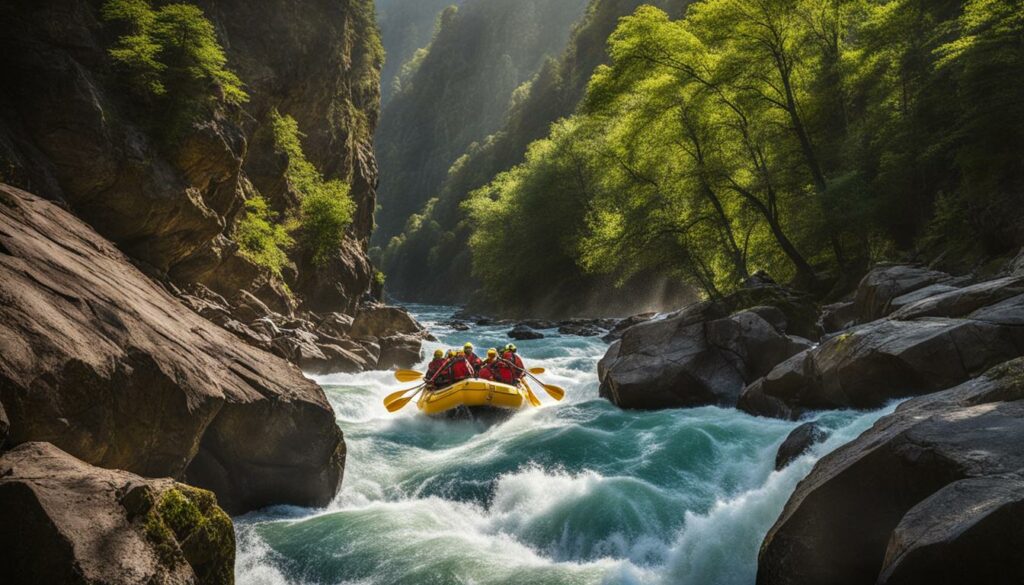
Whitewater rafting is an exhilarating paddlesport adventure that promises adrenaline-pumping excitement and unforgettable experiences. It involves navigating turbulent river rapids using an inflatable raft, requiring teamwork, paddling skills, and an adventurous spirit. Whitewater rafting offers a wide range of river difficulties, from thrilling Class IV and V rapids to more mellow floats suitable for beginners and families.
Whether you’re a seasoned rafter or a first-timer, mastering rafting techniques is crucial for a safe and enjoyable experience on the water. These techniques include paddle strokes, positioning in the raft, and reading river currents to navigate through obstacles. Professional guides and instructors are available to provide training and guidance, ensuring that you have the skills necessary to tackle the rapids.
Whitewater rafting is a thrilling adventure that allows you to connect with nature, test your limits, and create lasting memories with friends and family. It’s an opportunity to escape the everyday routine and immerse yourself in the beauty and power of rivers. As you paddle through the rapids, you’ll feel a surge of adrenaline and a sense of accomplishment. Whitewater rafting is more than just a thrilling adventure – it’s a way to connect with nature and experience the awe-inspiring power of rivers.
To embark on a whitewater rafting adventure, you’ll need the right equipment and gear. Rafts, paddles, helmets, and life jackets are essential for a safe and enjoyable experience. Professional rafting outfitters provide all the necessary equipment and expert guidance, ensuring your safety on the water. River rafting trips can range from a few hours to multi-day expeditions, allowing you to choose an adventure that suits your preferences and schedule.
Whitewater Rafting Equipment and Gear
| Equipment | Description |
|---|---|
| Raft | An inflatable boat designed to navigate river rapids. |
| Paddles | Used to propel and steer the raft through the rapids. |
| Helmets | Protective headgear to absorb impact during rapids. |
| Life Jackets | Personal flotation devices that keep you buoyant in the water. |
| Wetsuits and Drysuits | Used to protect against cold water and hypothermia. |
| Throw Bags | Ropes with a bag attached, used for rescue and retrieval. |
| River Shoes | Durable footwear with good traction for walking on riverbeds. |
Whitewater rafting is about more than just the rapids. It’s an opportunity to appreciate the stunning natural landscapes surrounding the rivers, witness wildlife in their natural habitat, and forge connections with your fellow rafters. Whether you’re seeking an adrenaline rush or a peaceful float down a scenic river, whitewater rafting offers an adventure like no other.
Discover the Different Paddle Sports and Disciplines
Paddle sports encompass a wide range of activities and disciplines, including canoeing, kayaking, paddleboarding, and rafting. Each sport has its unique characteristics, techniques, and equipment. Canoeing offers a serene experience, while kayaking provides thrill and speed. Standup paddleboarding combines elements of surfing and paddling, and whitewater rafting is an exhilarating adventure. Whether you prefer a tranquil paddle on a calm lake or an adrenaline-filled rapids ride, there’s a paddle sport for everyone to enjoy.
To better understand the differences between these paddle sports, let’s take a look at a comparative table:
| Paddle Sport | Characteristics | Techniques | Equipment |
|---|---|---|---|
| Canoeing | Serene and versatile | Single-bladed paddle | Canoe, paddle, life jacket |
| Kayaking | Fast-growing and exciting | Double-bladed paddle | Kayak, paddle, life jacket |
| Standup Paddleboarding (SUP) | The latest craze | Single-bladed paddle | Paddleboard, paddle, leash |
| Whitewater Rafting | Thrilling adventure | Paddling as a team | Raft, paddle, helmet, life jacket |
As you can see, each paddle sport offers a unique experience and requires different techniques and equipment. Whether you’re looking for a peaceful journey, a thrilling ride, or a combination of both, paddle sports provide endless opportunities for exploration and enjoyment on the water.
Single Blade Paddles: From Canoeing to Standup Paddleboarding
Single blade paddles play a crucial role in various paddle sports, including canoeing and standup paddleboarding (SUP). These paddles are specifically designed to provide precise maneuvering and control for each sport, allowing paddlers to glide through the water with ease.
When it comes to canoeing, a single-bladed paddle is used to propel the canoe forward. The design of the paddle allows for efficient strokes on one side, enabling paddlers to keep the canoe on a straight course or make precise turns. Canoeing paddles are typically longer than other paddles to accommodate the width of the canoe and the paddler’s position.
In SUP, single-bladed paddles are used to propel the paddleboard through the water. Paddlers stand on the board and use the paddle to alternate strokes on either side of the board, creating forward momentum. These paddles are generally shorter than canoeing paddles and are designed with a larger blade surface area to maximize efficiency and power.
| Paddle Sport | Paddle Type | Key Features |
|---|---|---|
| Canoeing | Single-bladed paddle | Precise maneuvering, control, longer length |
| Standup Paddleboarding (SUP) | Single-bladed paddle | Efficient strokes, larger blade surface area |
Mastering paddle techniques is essential in both canoeing and SUP to maximize efficiency and performance on the water. Proper hand placement, body positioning, and stroke technique are important factors to consider when using single blade paddles. With practice and experience, paddlers can refine their skills and enjoy the full benefits of these versatile paddles.
Benefits of Single Blade Paddles
- Enhanced maneuverability and control
- Efficient strokes for smooth propulsion
- Greater precision in navigation
- Maximized power and efficiency
- Versatility in different paddle sports
“The beauty of single blade paddles lies in their ability to provide precise control and efficient strokes, allowing paddlers to navigate with ease in both canoeing and standup paddleboarding.”
Dual Blade Paddles: The Versatility of Kayaking
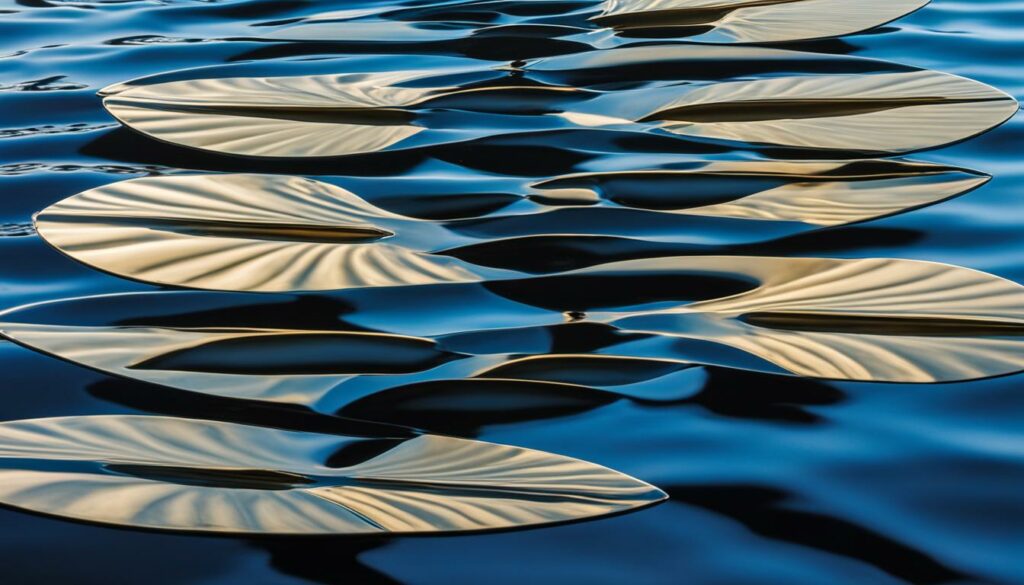
Kayaking is a thrilling paddle sport that offers versatility and maneuverability on the water. One of the key components of kayaking is the dual blade paddle, which allows paddlers to propel their kayak efficiently and smoothly. The dual blade paddle consists of blades on both ends of the shaft, enabling kayakers to utilize a double-bladed stroke to move forward and navigate through different water conditions.
There are various types of dual blade paddles available, each designed for different disciplines of kayaking. Whether you’re into sea kayaking, touring, whitewater, or recreational kayaking, there’s a paddle specifically tailored to enhance your performance and experience on the water. These paddles often come in different lengths, materials, and blade shapes, allowing kayakers to choose the one that best suits their preferences and needs.
Mastering kayak techniques is essential for efficient and effective paddling. With the right technique and a well-suited dual blade paddle, kayakers can maneuver their kayak with ease, navigate tight spaces, and glide across calm or turbulent waters. Learning proper stroke techniques, body positioning, and paddle placement will help kayakers maximize their power, control, and efficiency, resulting in an enjoyable and rewarding kayaking experience.
Kayaking Paddle Types:
| Paddle Type | Description |
|---|---|
| Sea Kayaking Paddle | A longer paddle with a narrower blade, designed for touring and long-distance kayaking in open water. |
| Touring Paddle | A versatile paddle suitable for various kayaking disciplines, offering a balance of power and maneuverability. |
| Whitewater Paddle | A shorter paddle with a wider blade, designed for navigating rapids and turbulent waters. |
| Recreational Paddle | A budget-friendly paddle ideal for beginners and casual kayakers, offering a good balance of performance and affordability. |
Whether you’re a beginner or an experienced kayaker, understanding the different paddle types and selecting the right dual blade paddle for your kayaking adventures will significantly enhance your performance and enjoyment on the water.
Paddling with Hands: Explore the World of Paddleboarding
Paddleboarding offers a unique experience where individuals use their hands to paddle through the water. This form of paddling requires kneeling or standing on a board and propelling oneself using arm strokes. Paddleboarding can be enjoyed in various settings, including flatwater lakes, rivers, and even in the ocean for wave riding. It is a versatile paddle sport that combines physical fitness, balance, and a connection to the water. Whether you prefer a leisurely paddle or a challenging workout, paddleboarding provides an enjoyable experience for all skill levels.
Paddleboarding, also known as standup paddleboarding (SUP), has gained significant popularity in recent years. It offers a unique perspective on the water, allowing paddlers to explore scenic locations and experience a sense of calmness. Paddling with hands adds a dynamic element to the sport, engaging different muscle groups and providing a full-body workout. The rhythmic movement of paddling creates a serene and meditative experience, connecting paddlers with nature and promoting overall well-being.
When paddleboarding with hands, it is important to maintain proper form and technique. Beginners should focus on maintaining a stable stance on the board and using controlled arm strokes to propel themselves forward. As you become more comfortable, you can experiment with different paddle strokes and techniques to increase speed and maneuverability. Paddleboarding with hands allows for a greater sense of control and freedom, as you can easily adjust your paddle strokes to navigate different water conditions and directions.
Whether you’re looking for a relaxing paddle on a calm lake or an adventurous ride on ocean waves, paddleboarding with hands offers a versatile and enjoyable experience. With its physical and mental benefits, paddleboarding is a fantastic way to stay active, explore the outdoors, and connect with the water. So grab a board, get out on the water, and discover the world of paddleboarding!
Additional Paddle Sports and Related Disciplines
In addition to the main paddle sports of canoeing, kayaking, paddleboarding, and whitewater rafting, there are several other related disciplines and activities that involve paddling. These disciplines offer unique challenges and opportunities for athletes to showcase their paddling skills and compete in races and events.
Dragon Boat Racing
Dragon boat racing is a team paddling sport that originated in ancient China and has gained popularity worldwide. It involves a crew of paddlers propelling a long boat with synchronized strokes. Races are held in various distances, ranging from 200 meters to several kilometers. Dragon boat racing requires teamwork, coordination, and endurance, making it an exciting and competitive paddle sport.
Canoe Sprint
Canoe sprint is a competitive paddle sport that takes place on flatwater over various distances. It involves paddlers propelling their canoes using a single-bladed paddle. Canoe sprint races range from short sprints of 200 meters to longer distances, such as 500 meters, 1000 meters, and even marathons. The sport requires speed, technique, and endurance, making it an exhilarating competition.
Kayak Racing
Kayak racing is another competitive paddle sport that involves paddlers propelling their kayaks using a double-bladed paddle. Like canoe sprint, kayak racing takes place on flatwater and includes various distances and disciplines. Paddlers compete in races ranging from short sprints to longer distances, such as 500 meters, 1000 meters, and marathon events. The sport requires speed, agility, and strategic tactics, offering thrilling and fast-paced competitions.
Rowing
Rowing is a popular sport where competitors propel a boat using oars. Unlike other paddle sports, rowing utilizes sweep oars, where each rower handles one oar with both hands. Rowing is often practiced in teams, with boats ranging from singles to eights. The sport requires strength, technique, and endurance, and it is widely recognized in both recreational and competitive settings.
These paddle sports disciplines provide unique opportunities for athletes to showcase their skills, compete in races, and immerse themselves in the thrill of paddling. Whether it’s the teamwork and synchrony of dragon boat racing, the speed and endurance of canoe sprint and kayak racing, or the strength and technique of rowing, these disciplines offer exciting adventures on the water.
Paddle Sports Equipment and Accessories
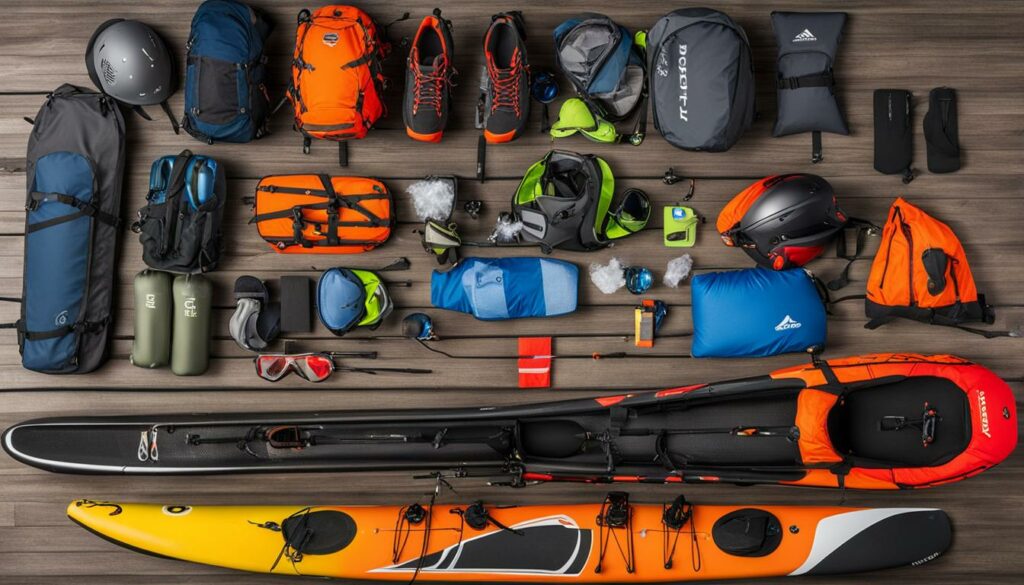
Paddle sports require specific equipment and accessories to enhance safety, performance, and comfort on the water. Whether you’re into canoeing, kayaking, or paddleboarding, having the right gear is essential for an enjoyable and successful experience. Let’s take a closer look at some of the essential equipment and accessories for paddle sports.
Paddles
The paddle is the most vital piece of equipment in any paddle sport. It allows you to propel yourself through the water and control your movements. Paddles come in different materials, lengths, and designs, depending on the type of paddle sport you’re engaged in. For example, canoeing requires single-bladed paddles, while kayaking and standup paddleboarding use double-bladed paddles for greater efficiency and maneuverability.
Life Jackets
Also known as personal flotation devices (PFDs), life jackets are essential for ensuring your safety on the water. They provide buoyancy and help you stay afloat in case of accidental immersion or emergencies. When choosing a life jacket, ensure it is approved by the appropriate regulatory authorities and fits properly. Different types of life jackets are available, including those specifically designed for paddle sports.
Accessories
There are various accessories available to enhance your paddle sports experience. Canoeing enthusiasts may benefit from accessories such as knee pads, which provide comfort during long trips, and storage solutions like waterproof bags or barrels to keep your gear dry. Kayakers can opt for accessories like cockpit covers to protect the interior of their kayaks from water and debris. Standup paddleboarders may find accessories like leashes, which attach the board to your ankle, and fins to enhance stability and maneuverability, valuable additions to their gear.
By investing in quality paddles, life jackets, and accessories, you can ensure a safe and enjoyable paddle sports experience. Remember to always check and maintain your gear for optimal performance and safety on the water.
Paddle Fitness and Health Benefits
Paddle sports not only offer thrilling adventures on the water but also provide numerous fitness and health benefits. Engaging in paddle sports, such as canoeing, kayaking, paddleboarding, and whitewater rafting, can give you a full-body workout that targets various muscle groups, including the arms, shoulders, core, and legs. Paddling activities require continuous movement, which helps improve cardiovascular endurance, strength, and flexibility.
One specific paddle sport that stands out in terms of fitness benefits is paddleboarding. This low-impact water activity offers a fantastic workout that improves balance, coordination, and core stability. By standing on a board and propelling yourself through the water, you engage multiple muscle groups and challenge your body in a unique way.
Aside from the physical benefits, paddle sports also contribute to mental well-being. Being out in nature and surrounded by the water can promote relaxation, reduce stress levels, and boost overall mental health. The calming effect of the water combined with the thrill of paddling creates a sense of serenity and joy.
Overall, paddle sports provide a fun and exciting way to stay active and maintain your overall fitness. Whether you’re looking to improve your strength, enhance your cardiovascular health, or simply enjoy the beauty of nature, paddle sports offer a unique and rewarding experience.
Techniques and Tips for Paddle Sports Beginners
For beginners venturing into the world of paddle sports, it’s important to learn the proper techniques and tips to ensure a safe and enjoyable experience on the water. Whether you’re trying canoeing, kayaking, paddleboarding, or whitewater rafting, mastering the basics will help build a strong foundation for your paddling skills. Here are some essential techniques and tips for beginners:
- Proper Paddle Grip: Start by holding the paddle with a relaxed grip, ensuring your hands are shoulder-width apart. Your top hand should be slightly above your eye level, while your bottom hand should be lower and closer to the paddle blade. This grip will provide you with better control and power during your strokes.
- Basic Stroke Technique: Begin by practicing the basic paddle stroke, which involves reaching forward with the paddle blade, submerging it in the water, and pulling it backward. Keep your arms straight and use your torso to generate power, engaging your core muscles. Practice maintaining a steady rhythm and evenly distributing your strokes on both sides of the kayak or canoe.
- Balance and Body Positioning: Proper balance is crucial in paddle sports. Sit or stand with a straight back, engaging your core muscles for stability. Keep your weight centered and evenly distributed to maintain balance and prevent capsizing. For paddleboarding, practice finding your balance by starting on calm water and gradually progressing to more challenging conditions.
- Safety Precautions: Always wear a properly fitting and approved life jacket or personal flotation device (PFD) when participating in paddle sports. Familiarize yourself with local water regulations, weather conditions, and potential hazards. It’s also advisable to paddle with a buddy or inform someone of your paddling plans, especially when venturing into unfamiliar waters.
As a beginner, it’s important to take things slow, start in calm waters, and gradually progress to more challenging environments as your skills improve. Consider taking lessons or joining guided tours to receive expert instruction and guidance. Remember to have fun, stay hydrated, and respect the natural environment as you embark on your paddle sports journey.
The Thrill and Adventure of Paddle Sports
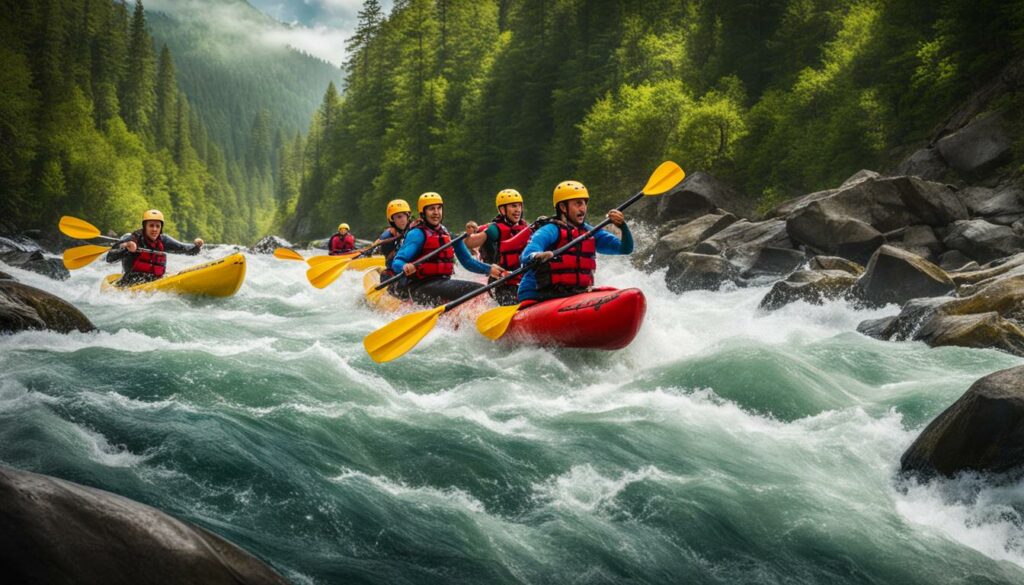
Paddle sports offer a unique blend of thrill, excitement, and adventure on the water. Whether you’re navigating rapids in a whitewater raft, exploring serene lakes in a canoe, or surfing waves on a paddleboard, these activities provide an adrenaline rush and a sense of accomplishment. Paddle sports allow you to immerse yourself in nature, discover new landscapes, and challenge yourself physically and mentally.
The joy of gliding across the water, the connection with nature, and the camaraderie with fellow paddlers make paddle sports a truly memorable experience. The thrill of conquering challenging rapids or riding the perfect wave is unmatched. It’s an opportunity to push your limits, overcome fears, and experience the raw power of the water.
“Paddle sports offer a unique blend of thrill, excitement, and adventure on the water.”
Embarking on a paddle sports adventure also means exploring untouched natural environments. Whether you’re surrounded by towering cliffs, lush forests, or vast open waters, paddle sports allow you to access remote areas that are otherwise inaccessible. The serenity and beauty of these natural landscapes create an unparalleled sense of peace and tranquility.
| Paddle Sports Excitement | Thrill Rating (1-5) |
|---|---|
| Whitewater Rafting | 5 |
| Kayaking | 4 |
| Paddleboarding | 3 |
| Canoeing | 3 |
Whether you’re a thrill-seeker or simply want to enjoy the beauty of the great outdoors, paddle sports offer an adventure for everyone. From the rush of adrenaline to the serenity of the water, there’s no denying the excitement and joy that paddle sports bring.
Conclusion
Paddle sports offer a thrilling and rewarding experience on the water, with a variety of activities to suit all skill levels and interests. Whether you’re canoeing, kayaking, paddleboarding, or whitewater rafting, there’s something for everyone to enjoy. These sports provide not only physical fitness benefits but also mental well-being and a connection with nature.
Throughout this article, we’ve explored the different types of paddle sports, from the serene and versatile canoeing to the fast-growing excitement of kayaking and the latest craze of standup paddleboarding. We’ve discussed the various techniques, equipment, and accessories that can enhance your experience and improve your skills in these sports.
By participating in paddle sports, you can immerse yourself in thrilling adventures, challenge yourself, and experience the beauty of the water. Whether you’re gliding across a calm lake or navigating challenging rapids, paddle sports offer an adrenaline rush and a sense of accomplishment. So, grab your paddle, get on the water, and discover the excitement and adventure of paddle sports for yourself.
FAQ
What are paddle sports?
Paddle sports encompass a variety of water activities that require the use of a paddle to navigate and propel a vessel. These include canoeing, kayaking, paddleboarding, and rafting.
What is canoeing?
Canoeing is a popular paddle sport that offers a serene and versatile experience on the water. Canoes are long and slender boats that can be paddled solo or in tandem.
What is kayaking?
Kayaking is a fast-growing and exciting paddle sport. Kayaks are similar to canoes in shape but are typically smaller and more maneuverable.
What is standup paddleboarding (SUP)?
Standup paddleboarding is a relatively new and rapidly growing paddle sport that combines elements of surfing and paddling. Participants stand on a board and use a paddle to propel themselves through the water.
What is whitewater rafting?
Whitewater rafting is a thrilling paddlesport adventure that involves navigating turbulent river rapids using an inflatable raft. It requires teamwork, paddling skills, and an adventurous spirit.
What are the different types of paddle sports?
Paddle sports include canoeing, kayaking, paddleboarding, and rafting. Each sport has its unique characteristics and techniques.
What types of paddles are used in canoeing and standup paddleboarding?
Canoeing utilizes a single-bladed paddle, while standup paddleboarding requires a single-bladed paddle as well.
What type of paddle is used in kayaking?
Kayaking utilizes a dual blade paddle, which has blades on both ends of the shaft.
How does paddleboarding differ from other paddle sports?
Paddleboarding is a form of paddling where individuals use their hands to paddle through the water. It can be enjoyed in various settings and provides a versatile paddle sport experience.
Are there any other paddle sports besides canoeing, kayaking, paddleboarding, and rafting?
Yes, there are other related disciplines and activities, including dragon boat racing, canoe sprint, kayak racing, and rowing.
What equipment and accessories are needed for paddle sports?
Paddle sports require specific equipment such as paddles, life jackets, helmets (for whitewater paddling), and specialized gear such as spray skirts (for kayaking).
What fitness and health benefits do paddle sports provide?
Paddle sports offer a full-body workout, improve cardiovascular endurance, and promote mental well-being. Standup paddleboarding, in particular, improves balance, coordination, and core stability.
What tips do you have for beginners in paddle sports?
Beginners should focus on proper paddling form, learn basic balance and safety techniques, and start with suitable equipment and instruction.
What makes paddle sports thrilling and adventurous?
Paddle sports offer a unique blend of thrill, excitement, and adventure on the water. They allow individuals to immerse themselves in nature, challenge themselves physically and mentally, and experience a sense of accomplishment.
